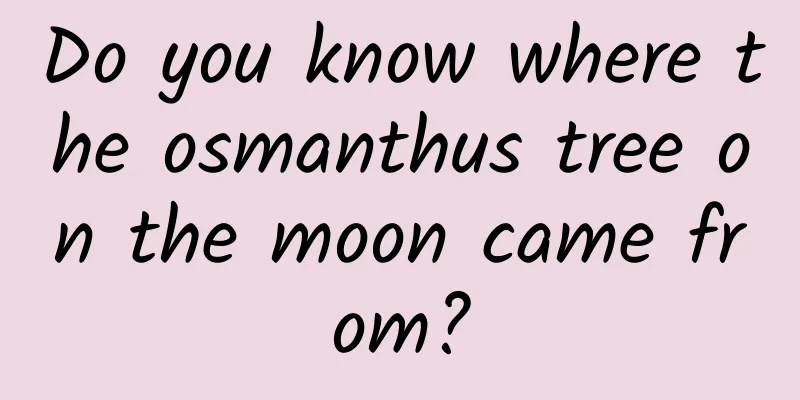Do you know where the osmanthus tree on the moon came from?

|
I remember when I was a child, on the night of the Mid-Autumn Festival, the cool breeze was blowing, while I was enjoying the mooncakes and appreciating the moon, my grandfather told me the myth of Wu Gang chopping down the osmanthus tree. I looked at the moon and was deeply fascinated by the osmanthus tree that could not be chopped down. Later, I learned that there is no Guanghan Palace on the moon, no Chang'e and Jade Rabbit, and the osmanthus tree that has been praised since ancient times is actually the lunar sea. It can be said that the moon is almost a dead place of black, white and gray. So, do you know what the "osmanthus tree" on the moon is, and how did it come from? The "Osmanthus Tree" is actually the Moon Sea Because it is locked by the Earth's tidal gravity, the Moon always revolves around the Earth with the same side. The rotation period of the Moon is the same as the revolution period, both of which are 27.32 days. The side of the Moon facing the Earth is called the near side, and the side away from the Earth is called the far side. The dark area on the near side is the so-called lunar sea ("Osmanthus tree"), which was named because it was once believed to be an ocean on the Moon before the invention of the telescope. But in fact, there is not a drop of water in the lunar sea! The front and back of the moon have a clear dichotomy┃ Source: adapted from the Internet The lunar seas are composed of dark basalt plains, mainly concentrated on the near side of the moon, covering one-sixth of the lunar surface and one-third of the near side. The far side of the moon is mainly composed of light-colored anorthosite highlands, lacking lunar seas, and is covered with dense impact craters (or craters). The observation results of NASA's lunar exploration mission GRAIL show that the thickness of the lunar crust on the near side of the moon is 30-40 kilometers, and the thickness of the lunar crust on the far side is 50-60 kilometers, which is about 20 kilometers thicker than the near side. The center of mass of the moon is on the side close to the earth. This asymmetry may be caused by the gravity of the earth. In summary, the moon shows a clear "duality": the front side has a thin crust, many dark lunar seas, and many low-lying plains; the back side has a thick crust, many light-colored plagioclase, and many rugged highlands. Schematic diagram of the moon's internal structure[1] The "Osmanthus tree" was created by an asteroid The origin of this "Osmanthus tree" can be traced back to 4.5 billion years ago. In the previous article, we talked about how the moon originated from a huge collision, and then it became a real fireball, like a phoenix reborn from the ashes. After hundreds of millions of years, it gradually cooled and solidified to form a rocky planet with a core-mantle-shell structure. However, the Phoenix Nirvana did not usher in permanent peace in the present world. Statistics on the impact craters on the lunar surface show that about 3.9 billion years ago, countless asteroids and comets bombarded the moon, forming large and small impact craters. This event is called the Late Heavy Bombardment (LHB) event. Under the bombardment of asteroids, the high-frequency impact generated a lot of heat, causing basalt magma from the lunar mantle to surge to the lunar surface, filling those impact craters, thus forming a vast lunar sea plain - "Osmanthus Tree". In a nutshell, "Osmanthus Tree" is formed by dark (dark because it contains mafic minerals such as olivine pyroxene) basalt magma filling the impact craters, all of which are caused by asteroids. Why do asteroids come to hit the moon? In fact, collisions between planetesimals were common in the early days of the solar system, and the moon’s origin from a large collision is the best proof of this. However, as planetesimals were removed from their orbits after the formation of the planets, the frequency of these planetesimals’ impacts on the planets should have slowed down rapidly. So what caused the frequency of asteroid impacts to suddenly increase 3.9 billion years ago? Scientists believe that this is most likely related to the migration of some large planets in the early solar system. The interaction between massive gaseous planets (such as Jupiter and Saturn) and the planetesimal disk caused orbital migration. The migration of these behemoths into the inner solar system greatly disrupted the gravitational balance, causing a large number of small celestial bodies originally located in the asteroid belt to deviate from their orbits, thus triggering the late heavy bombardment event in the inner solar system that lasted about 100 million years. A brief history of the formation of the Moon[1] Did the asteroids at that time only hit the moon? During the Late Heavy Bombardment, asteroids were more likely to attack indiscriminately, ravaging all the terrestrial planets, as evidenced by the cratered surface of Mercury, while evidence of asteroid impacts on Earth has largely been erased by plate tectonics, volcanic activity, and erosion. The moon has no atmosphere and no plate tectonics, so most of the impact craters of varying sizes formed by asteroid impacts have been preserved intact, faithfully recording asteroid impact events throughout the entire history of the moon. Not only that, she also secretly recorded solar wind particle injections and micrometeorite impacts in her little notebook. Coincidentally, the generally accepted view in the scientific community is that the earliest life on Earth appeared 3.8 billion years ago, which is highly consistent with the timing of the Late Heavy Bombardment event, providing circumstantial evidence for the hypothesis of the extraterrestrial origin of life on Earth. Under the influence of asteroid impacts, the surface layer of the early Earth was covered with molten rock. ┃ Image source: Simone Marchi Looking forward to the new chapter On the night of Mid-Autumn Festival, we admire the moon poetically and feel that the years are peaceful. However, beneath the calm appearance of the moon, a thrilling past is hidden. If the moon is compared to a book, it is almost a 4.5 billion-year history of planetary violence in the solar system. my country's Chang'e 5 sampling site is located in the northwest of the Ocean of Storms on the front side of the lunar sea, representing the youngest lunar mare basalt to date. The study of the Chang'e 5 lunar return samples will surely add a new chapter to this history book! References: [1] Moon, 2020, Tiandi Publishing House. [2] Wieczorek et al. 2013. Science, 339(6120), 671–675. [3] Morbidelli et al. 2005. Nature, 435(7041): 462–465. [4] Gomes et al. 2005. Nature, 435(7041): 466–469. [5] Abramov et al. 2009, Nature, 459 (7245): 419–422. About the Author Jiang Yun Associate researcher at the Astrochemistry and Planetary Science Laboratory of Purple Mountain Observatory, Chinese Academy of Sciences. Research interests: petrology, mineralogy, isotope geochemistry and chronology of Martian, lunar and asteroid meteorites. Rotating Editor-in-Chief: Du Fujun Editor: Wang Kechao |
<<: In-depth analysis of "Peak Burst": What does the active Indian Ocean plate mean?
>>: The truth about mooncakes: What kind of cake can be called a mooncake?
Recommend
Xi'an high-end T-stage selection of boutique recommendations 24 hours a day online appointment arrangement
Xi'an high-end T-stage selection of exquisite...
How to make money by starting a short video business? How to make money through short video live streaming?
Many people want to start a business with short v...
5 minutes to understand the rules of Zhihu
Zhihu's traffic ranks 28th among domestic web...
How to prevent cardiovascular and cerebrovascular diseases in summer?
Author: Sun Taixin, Chief Physician, Beijing Elec...
Product operation and promotion: How to compete for traffic?
Recently, more and more people around me are talk...
5 steps to review event promotion!
Reviewing is different from summarizing. Summariz...
I never thought that eating eggs this way is more nutritious!
When I was a kid, I had to eat two boiled eggs ev...
Apple offers free replacement program for some iPhone XS, XS Max, and XR smart battery cases
In January 2019, Apple launched a smart battery c...
4 soft methods of app promotion that you may not know
Developing an APP is actually not difficult. The ...
The cold wave is coming, what does a double La Niña year mean?
According to the National Climate Center on Octob...
"Hydrogen Wind" Xu Lai: Unveiling the mystery of green hydrogen
Produced by Guangdong Science and Technology News...
100 essential tools for new media operations!
1 Graphics and text editor ◆135 Editor www.135edi...
SMS promotion is ineffective. What is the correct approach to SMS marketing?
In our daily lives, we are overwhelmed by marketi...




![Mirei human body sketching course [general quality with brushes]](/upload/images/67cc0bfaae457.webp)




